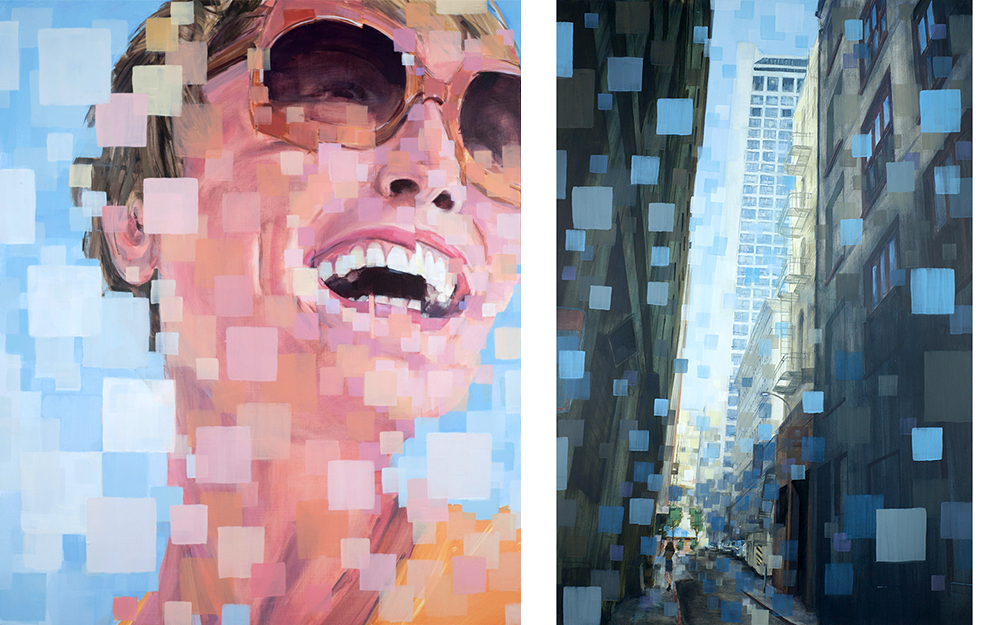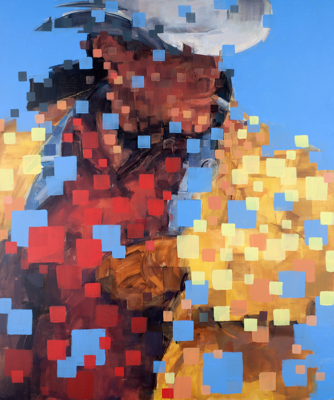
BY ANGELA ROMEO
David Bottoms lives and works in Joshua Tree. He and his wife, fiber artist, Anja Broenink, will be featured in the upcoming Hwy 62 Open Studio Artist Tours. The tour runs two weekends, October 13-14 and October 20-21. The couple is participating both weekends and is at Stop 57 on the tour.
Originally from Tulsa, Oklahoma, David lived in San Francisco and Amsterdam before moving to the High Desert in 2014. He received a Master of Fine Arts degree from the University of California Santa Barbara, following a BFA from the University of Oklahoma. Like many David found a type of artistic solace in the High Desert but deconstructed pixilation gives his work a very urban feel. And somehow it all fits so well along Highway 62.
Deconstruction in art is dialogue of questioning and challenging the meaning of what we see or read or hear. Think of John Cage and his composition 4’33” – the silence of not silence. The audience was left to create the piece. Consider the collaborative works of Cage with choreographer Merce Cunningham. Cunningham often left his dancers in the dark until the moment of the performance. These examples of deconstruction are no less challenging then David’s paintings.
 “These works represent part of my ongoing effort to push painting beyond realistic depiction and towards a more dynamic, abstracted realism,” said David. “I began to deconstruct the imagery I was painting, trying to free-up interpretive possibilities. I wanted to introduce a conceptual element into and onto the picture plane. The result was a kind of organic pixelism.”
“These works represent part of my ongoing effort to push painting beyond realistic depiction and towards a more dynamic, abstracted realism,” said David. “I began to deconstruct the imagery I was painting, trying to free-up interpretive possibilities. I wanted to introduce a conceptual element into and onto the picture plane. The result was a kind of organic pixelism.”
His work “feels” like a photograph broken into the tiny color dots that combine to create a the image as a whole. It is not pointillism. It is not abstraction. It is a form of pixilation deconstruction. The viewer’s eye pulls the elements together to create a familiar image. The discomfort, as such, is the effort the viewer must make to “see” the work as it is. The challenge to the viewer is to trust that the pieces have not fooled the eye.
“My first years in art school were modeled on classic training, lots of life drawing, history and theory. When studies abruptly switched to Modernism, I was thrilled with it, but perplexed. How to resolve the traditional approach to painting with the modern? I have always had this push/pull relationship with traditional image making.”
“My answer to that is in this work. I break the picture plane apart, reduce shapes to tiles of color, disperse the pieces into the surrounding space, and otherwise disrupt visual continuity. My goal is to create tension between traditional elements of visual art; two-dimensional space versus three dimensional, negative space versus form, color versus line,” continued David.
“My interest now is about the constructive deconstruction of imagery. The pieces matter more than the whole. Conceptually, the painted pixels mean more than the painted image. So there is a progression towards more deconstruction, more abstraction, more pure color painting. To achieve this I am a recognizable element to draw the viewer into the very space I am deconstructing. I want the viewer to experience the dissolution a familiar spatial illusion, and hopefully, the realization of a more dynamic one.”
David’s work, like Monet’s Nymphéas (Waterlilies) series, is a progression of subject and perspective. Stay tuned because David has just begun the journey of deconstruction.
For more information on David Bottoms visit www.dbottoms.com. For more information on the upcoming Hwy 62 Open Studio Art Tours visit www.hwy62arttours.org. Catalogues are also available at Colliding Worlds Fine Art Gallery, 68-895 Perez Road, Cathedral City CA.











































